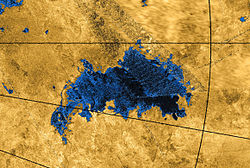 Jingpo Lacus in a false-color
synthetic aperture radar image of Titan's north polar region. An extension of
Kraken Mare enters the view at upper left. | |
| Feature type | Lacus |
|---|---|
| Coordinates | 73°N 336°W / 73°N 336°W |
| Diameter | 240 km [note 1] |
| Eponym | Jingpo Lake |
Jingpo Lacus is a lake in the north polar region of Titan, [1] the planet Saturn's largest moon. It and similarly sized Ontario Lacus [2] are the largest known bodies of liquid on Titan after the three maria ( Kraken Mare, Ligeia Mare, and Punga Mare). [3] It is composed of liquid hydrocarbons (mainly methane and ethane). It is west of Kraken Mare at 73° N, 336° W, roughly 240 km (150 mi) long, [1] [note 1] similar to the length of Lake Onega on Earth. Its namesake is Jingpo Lake, [1] a lake in China.
Specular reflection
On 8 July 2009, Cassini's Visual and Infrared Mapping Spectrometer (VIMS) observed a specular reflection in 5 µm infrared light off Jingpo Lacus at 71° N, 337° W. (This has sometimes been described less accurately as at the southern shoreline of Kraken Mare. [4]) Specular reflections indicate a smooth, mirror-like surface, so the observation corroborated the inference of the presence of a large liquid body drawn from radar imaging. The observation was made soon after the north polar region emerged from 15 years of winter darkness. [5]
Gallery
-
Synthetic aperture radar image (top) overlaid onto a visible light/ infrared image of Titan's north polar region, showing Jingpo Lacus (at center) and other liquid bodies (Kraken Mare at bottom, Ligeia Mare at right, and Punga Mare) outlined in blue.
-
Specular reflection off Jingpo Lacus, observed by the Cassini probe on July 8, 2009
See also
Notes
References
- ^ a b c "Jingpo Lacus". Gazetteer of Planetary Nomenclature. USGS Astrogeology Science Center. 2010-03-29. Feature ID 14655. Archived from the original on 2018-09-03. Retrieved 2012-03-17.
- ^ "Titan lacūs". Gazetteer of Planetary Nomenclature. USGS Astrogeology Science Center. Retrieved 2012-03-17.
- ^ "Titan maria". Gazetteer of Planetary Nomenclature. USGS Astrogeology Science Center. Archived from the original on 2019-06-21. Retrieved 2012-03-16.
- ^ Cook, Jia-Rui C. (2009-12-17). "Glint of Sunlight Confirms Liquid in Northern Lake District of Titan". NASA. Archived from the original on 2018-06-04. Retrieved 2009-12-18.
- ^ Lakdawalla, Emily (2009-12-17). "Cassini VIMS sees the long-awaited glint off a Titan lake". The Planetary Society. Archived from the original on 2019-08-21. Retrieved 2009-12-17.


